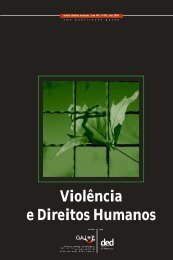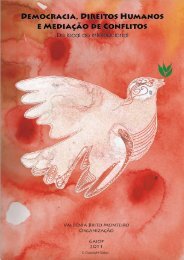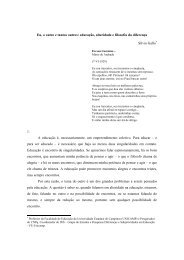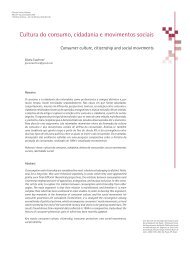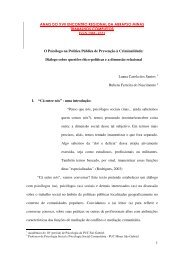12Executive Summary2Homicide has reached epidemic levels in Brazil. The nationalhomicide rate is among the highest in the Americas and in the world.Among the thousands of killings registered every year in Brazil,extrajudicial, summary or arbitrary executions merit special concern.These are incidents in which authorities, or private agents acting with theexplicit or implicit support of authorities, kill civilians without legitimatejustification, such as self defense or the defense of another. Unfortunately,in Brazil, authorities fail to maintain statistics on the incidence of thisabusive practice. That failure is evidence of the unfortunate lack of prioritythat the government affords to this vital matter.This publication seeks to arrive at an approximation both of theoverall figures and the nature of the practice of extrajudicial, summary orarbitrary executions. We know, for example, that official Ministry ofJustice data placed the number of homicides in the first semester of 1999 at23.3 thousand, which would lead to a total of 46.6 thousand for the fullyear, at a constant per-semester rate. Of this total, the National HumanRights Movement (MNDH) Database recorded and classified casesreported in Brazilian print media sources in eighteen of the nation'stwenty-seven states (including the federal district) totalling 13,917 cases in1999, the year of our study. Within this universe, in 1,148 cases, or 8.25%of the total, the media sources cited police officers or death squads asresponsible for the killings. Applying this percentage to the total of 46.6thousand for 1999, we arrive at the approximate figure of 3,840 killings bypolice and death squads that year.At the same time, data from some states provides a clearer vision ofthe nature of these homicides. While true that there may exist anoccasional death squad without any ties to the police, studies done in
13recent years demonstrate that these groups almost always include one ormore former or current police officer and, even when they do not,frequently rely on the informal support of the police. Similarly, not allcases of homicide committed by the police may fairly be characterized asextrajudicial, summary or arbitrary executions. Yet, there can be littledoubt that a very high percentage of these killings must be so classified. Inthis regard, São Paulo provides an interesting case study.A study by the Police Ombudsman (Ouvidoria da Polícia) for theState of São Paulo reviewed the autopsy reports and accompanyinginformation for 222 persons killed by police during 1999 (one third of thetotal number of victims of homicide by police during the year of ourstudy). The Ombudsman concluded that 52.6% of the victims had beenshot from behind; 23% had been shot five or more times and nearly 36%of the victims had been shot in the head. These results suggest thatmanyone may conclude the majorityhad been executed and not killedduring legitimate gun battles using appropriate force, as authoritiesroutinely allege. To estimate the proportion of executions nationally, let ususe 50% as a rough estimate of the percentage of police killings that shouldbe classified as extrajudicial, summary or arbitrary executions.In sum, in the first six months of 1999, the São Paulo police killed489 civilians, or one person every nine hours. If we use 50% as thepercentage of killings by police that should be classified as executions, inthe State of São Paulo alone, the total would reach approximately 500victims for the police alone. If we apply this percentage to the projectedtotal number of killings by police and death squads, the total number ofexecutions for 1999 would be 1,920.The report not only includes figures that allow for estimations ofthe gravity of the problem in global terms, but also analyzes available datato profile how, when, why, by whom and against whom these homicidesare committed. This analysis focuses specifically on homicides withcharacteristics of extrajudicial, summary or arbitrary executions. In mediareportedcases of homicides committed by police and death squads, forexample, one sees that 81.79 percent were attributed to the policecompared with16.90 percent for death squads. Focusing on the victimsone sees that while women comprise 10.34 percent of homicide victims
- Page 1 and 2: Extrajudicial, Summary or Arbitrary
- Page 3: In memory of all the victims ofextr
- Page 6 and 7: PART TWO1. Cases of Extrajudicial,
- Page 9: 91IntroductionINTRODUCTIONThe prese
- Page 14 and 15: 14overall, in cases with indicia of
- Page 16 and 17: 16A Brief Overviewof Extrajudicial,
- Page 18 and 19: 18equally valid in the case of extr
- Page 20 and 21: 20With the gradual transition from
- Page 22 and 23: 22carry out land reform.This practi
- Page 24 and 25: 24extrajudicial, summary or arbitra
- Page 26 and 27: 26Next, we analyze a subset of thes
- Page 28 and 29: 28At the same time, the public inte
- Page 30 and 31: 30dia-reported cases is registered
- Page 32 and 33: 32Of these media-reported cases att
- Page 34 and 35: 34POLICE VIOLENCEIn the State of S
- Page 36 and 37: 36Table 05:Distribution of Victims
- Page 38 and 39: 38Analyzing media-reported homicide
- Page 40 and 41: 40Tabela 10:Distribution of Victims
- Page 42 and 43: 42The discourse that characterizes
- Page 44 and 45: 44To these reasons, one other justi
- Page 46 and 47: 46responded favorably (either "agre
- Page 48 and 49: 48Legal Aspectsof Extrajudicial,Sum
- Page 50 and 51: 50one-year legacy of authoritariani
- Page 52 and 53: 52the crime of torture in accordanc
- Page 54 and 55: 54The research presented in this re
- Page 56 and 57: 56impunity stimulates the practice
- Page 59: Part Two
- Page 62 and 63:
62delay, the accused were freed in
- Page 64 and 65:
64as Lea, who affirmed that he was
- Page 66 and 67:
66Rodrigues then kicked the victim'
- Page 68 and 69:
68penitentiary agent Severino Augus
- Page 70 and 71:
703.2. Welington Carlos de Melo, 17
- Page 72 and 73:
72shotgun, injuring Odete Cavalcant
- Page 74 and 75:
74Upon hearing the youths' explanat
- Page 76 and 77:
76carried the minor by his feet to
- Page 78 and 79:
78threatening them with a .38 calib
- Page 80 and 81:
80The police were accused in an Osa
- Page 82 and 83:
82a police station. His mother drov
- Page 84 and 85:
84hands on the roof of the car when
- Page 86 and 87:
86the bathroom. When the police fou
- Page 89 and 90:
89253Recommendations2.1 Invite the
- Page 91 and 92:
91should be authorized to subpoena
- Page 93 and 94:
93and psychological assistance.2.9
- Page 95 and 96:
952.14 Absolutely Prohibit the Use
- Page 97:
972.19 Create a System of CriminalD
- Page 101 and 102:
101ANational HumanRights Movement(M
- Page 103 and 104:
103victims of homicides, it is equa
- Page 105 and 106:
105Ceará, Piauí, Rio Grande do No
- Page 107 and 108:
10713. Mott, Luiz. Violação dos D
- Page 109 and 110:
109In Brazil, CRS supports local pa
- Page 111 and 112:
111human rights organizations locat
- Page 113 and 114:
113National Human Rights Movement(M
- Page 115 and 116:
115rapporteurs to develop civil soc
- Page 117 and 118:
117AcknowledgmentsTo the Brazilian
- Page 119 and 120:
119Office for Legal Assistance to G



